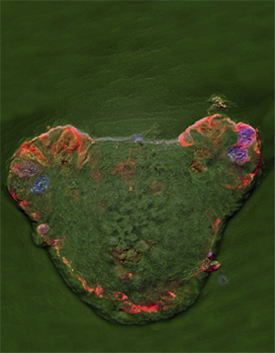
Human are “super-organism” composed of human cells and trillions of bacteria reside in and on our body, commonly referred as commensal bacteria. The mutual beneficial relationship between host and commensal bacteria is referred as symbiosis. Commensal bacteria are of vital importance to host health, and dysbiosis has been connected to many disorders, including metabolic syndromes, inflammatory bowel disease (IBD), and autism spectrum disorders.
Over 90% of commensal bacteria reside in intestinal lumen. Commensal bacteria and host mucosal immunity reciprocally interact and achieve a delicate balance, termed as intestinal homeostasis. Disrupted intestinal homeostasis induces dysbiosis and a range of dysbiosis-associated syndromes. Paneth cells, secretory epithelial cells at the bottom of small intestinal crypts, play a vital role in maintaining intestinal homeostasis by secreting a range of bactericidal factors into the intestinal lumen. Studies have put Paneth cells at the center stage of pathogenesis of IBD.
In a cover story of Nature Immunology entitled "Commensal Bacteria Direct Selective Cargo Sorting to Promote Symbiosis", ZHANG Qin and colleagues (led by Prof. LIU Zhihua) at the Institute of Biophysics of Chinese Academy of Sciences reported that symbiotic bacteria promote symbiosis by directing selective cargo sorting in Paneth cells through orchestration of host factors of Nod2 (nucleotide-binding oligomerization domain 2) and LRRK2 (Leucine-rich repeat kinase 2), both of which are encoded by IBD-associated genes.
Commensals recruit Nod2 and LRRK2 onto lysozyme-containing vesicles, which subsequently recruit a small GTPase, Rab2a, a master regulator of intracellular membrane trafficking. Deficiency of Nod2, Lrrk2, or Rab2a, or depletion of commensals results in lysosomal degradation of lysozyme in Paneth cells and renders the hosts more susceptible to intestinal infection.
This study illustrates a novel mechanism that host factors and commensal bacteria collaborate to direct an event of lysozyme selective sorting to promote symbiosis, and such collaboration may put the host at the risk of intestinal infection and inflammation.
In the column NEWS AND VIEWS of this journal, Dr. Philpott of University of Toronto said “the findings of Zhang et al. identify a new paradigm in host-microbiota homeostasis in which two CD-associated proteins, Nod2 and LRRK2, participate in a common axis important for the proper secretion of lysozyme by Paneth cells to ensure protection of the intestinal barrier.”

Figure: The cover of Nature Immunology. (Original image by ZHANG Qin. Artwork by Lewis Long.)

86-10-68597521 (day)
86-10-68597289 (night)

86-10-68511095 (day)
86-10-68512458 (night)

cas_en@cas.cn

52 Sanlihe Rd., Xicheng District,
Beijing, China (100864)

